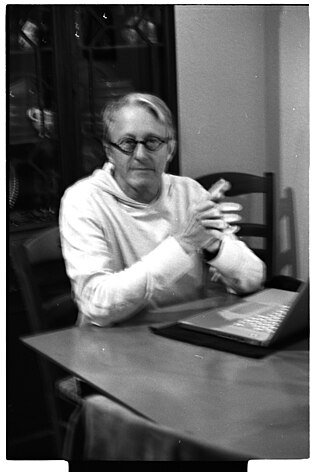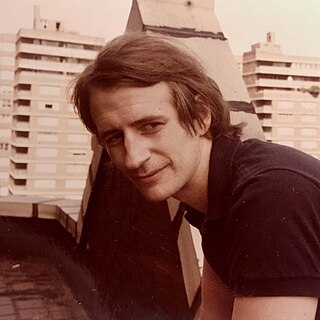Related Research Articles

Ken Jacobs is an American experimental filmmaker. His style often involves the use of found footage which he edits and manipulates. He has also directed films using his own footage.

Lord of the Universe is a 1974 American documentary film about Prem Rawat at an event in November 1973 at the Houston Astrodome called "Millennium '73". Lord of the Universe was first broadcast on PBS on February 2, 1974, and released in VHS format on November 1, 1991. The documentary chronicles Maharaj Ji, his followers and anti-Vietnam War activist Rennie Davis who was a spokesperson of the Divine Light Mission at the time. A counterpoint is presented by Davis' Chicago Seven co-defendant Abbie Hoffman, who appears as a commentator. It includes interviews with several individuals, including followers, ex-followers, a mahatma, a born-again Christian, and a follower of Hare Krishna.
TVTV was a San Francisco-based video collective that produced documentary video works using guerrilla art techniques.
Rea Tajiri is an American video artist, filmmaker, and screenwriter, known for her personal essay film History and Memory: For Akiko and Takashige (1991).
Peter d'Agostino is an artist and a professor of Film and Media Arts, Temple University, Philadelphia.

Chip Lord is an American media artist and Professor Emeritus, UC Santa Cruz and residing in San Francisco. He is best known for his work with the alternative architecture and media collective known as Ant Farm, which he co-founded with Doug Michels in 1968. His work generally takes a satirical look at American myths and legends, they are often "nostalgic, but edged with an ironic detachment."
The Videofreex were a pioneering video collective who used the Sony Portapak for countercultural video projects from 1969 to 1978. They were founded in 1969 by David Cort, Mary Curtis Ratcliff and Parry Teasdale, after Cort and Teasdale met each other at the Woodstock Music Festival. Other early members include Skip Blumberg, Chuck Kennedy, Davidson Gigliotti, Bart Friedman, Carol Vontobel, Nancy Cain, and Ann Woodward, with dozens of additional collaborators participating in the group's cooperative projects.
Electronic Arts Intermix (EAI) is a nonprofit arts organization that is a resource for video and media art. An advocate of media art and artists since 1971, EAI's core program is the distribution and preservation of a collection of over 3,500 new and historical video works by artists. EAI has supported the creation, exhibition, distribution and preservation of video art, and more recently, digital art projects.
Forcefield was an American noise band and art collective, founded in 1997 in Providence, Rhode Island, closely associated with Fort Thunder.
TV Lab was a program founded at Thirteen/WNET public television station in 1972 by David Loxton with support from the Rockefeller Foundation and New York State Council on the Arts. The program provided artists with advanced video making equipment through an artist-in-residence program. Between 1975 and 1977, the Video Tape Review series was established and broadcast through TV Lab. David Loxton created TV Lab's Independent Documentary Fund in 1977, aiming to provide funding for the creation of independent documentaries. Unable to match funds from the National Endowment for the Arts, the IDF and TV Lab lost support, eventually ending in 1984.

Dimitri Devyatkin is an American director, producer, screenwriter, video artist, and journalist. Devyatkin uses elements of humor, art and new technology in his work. He is known as one of the first video makers to combine abstract synthesized imagery with camera footage. His programs have been broadcast domestically and internationally on ABC, PBS, Channel 4, WDR, France 3, TF1 and Channel One Russia. His works consist of digital media, computer art, broadcast news and feature filmmaking. His activities in the creation of new independent US filmmaking have been documented by Jonas Mekas in "Birth of a Nation" (1997).
Cara DeVito is an American video producer, journalist, visual artist and video artist. A graduate of Beloit College, she received her BA in psychology and photography in 1973. She was awarded a Nieman Fellowship by Harvard University in 1998.
Four More Years is a 1972 documentary covering the 1972 Republican National Convention produced by Top Value Television. The title of the film refers to Richard Nixon's re-election slogan. The convention named Nixon as the Presidential nominee and Spiro Agnew as the nominee for Vice President. All filming takes place on the site of the convention center in Miami Beach, Florida. It was TVTV's second production, after The World's Largest TV Studio (1972), which covered the Democratic Convention one month prior.
Anda Korsts was a Chicago-based video artist and journalist. She was the founder of Videopolis, Chicago's first alternative video space, and worked with TVTV, a national video collective. She was one of the first of many new artists to use the portable camcorder as a tool for art making and radical journalism.
Frank Gillette is an American video and installation artist. Interested in the empirical observation of natural phenomena, his early work integrated the viewer's image with prerecorded information. He has been described as a "pioneer in video research [...] with an almost scientific attention for taxonomies and descriptions of ecological systems and environments". His seminal work Wipe Cycle –co-produced with Ira Schneider in 1968– is considered one of the first video installations in art history. Gillette and Schneider exhibited this early "sculptural video installation" in TV as a Creative Medium, the first show in the United States devoted to Video Art. In October 1969, Frank Gillette and Michael Shamberg founded the Raindance Corporation, a "media think-tank [...] that embraced video as an alternative form of cultural communication.

Victor Masayesva Jr. is a Hopi filmmaker, video artist, and photographer. Born on the Hopi Reservation of Arizona and growing up in Hotevilla, Masayesva's artistic career reflects his active participation with the Hopi community and his body of work promoting Hopi culture and worldview. Scholar Martin Padget considers Masayesva "one of the most influential Indigenous filmmakers and photographers of his generation." Masayesva's films and photographs are diverse and complex in nature, often employing diverse visual languages, and an experimental approach towards media. The majority of his films are in the Hopi language and are destined for his community, especially to pass-on traditional teachings to youth. Masayesva has also been personally involved in promoting indigenous media, both in the United States and internationally.
Madeleine Yayodele Nelson was an American percussionist and composer. She specialized in playing the West African shekere. She also played the djembe drum, the mbira thumb piano and the calabash.
Global Village Video was a pioneering Manhattan-based media center that operated from the late 1960s to the 1980s. It produced and showcased "Guerrilla TV" style video documentaries that featured subject matter and stylistic qualities not seen on mainstream television of the period. Using the battery-operated Sony CV video portapak introduced in 1968, Global Village also trained numerous artists and activists in the new technology, launched the first major video and film festival devoted solely to documentaries, as well as spearheaded a movement to get the work of independent producers on public television.
Shalom Gorewitz is an American visual artist. Gorewitz was among the first generation of artists who used early video technology as an expressive medium. Since the late 1960s, he has created videos that "transform recorded reality through an expressionistic manipulation of images and sound". His artworks often "confront the political conflicts, personal losses, and spiritual rituals of contemporary life". Gorewitz has also made documentary videos.

Ed Bowes is a filmmaker, writer, and director who pioneered the use of video as cinema. The first person to make a feature-length film in video, he used poets, musicians, artists, video- and filmmakers as performers in films such as Romance (1975) and Better, Stronger (1978–79). As a result of the notice given to his camera work, Bowes began his long career as a cinematographer for filmmakers and video artists including Kathryn Bigelow, Lizzie Borden, Vito Acconci, and Robert Longo, among others. In the 1970s, he was instrumental in creating early exhibitions of video art at MoMA, The Kitchen, and other Downtown New York venues. He taught advanced filmmaking for more than three decades at the School of Visual Arts, where he influenced several generations of contemporary filmmakers. His work is in the collection of The Museum of Modern Art, New York, and Moderna Museet in Stockholm, Sweden. It is also represented in The Kitchen Archive at The Getty Research Institute and the Long Beach Museum of Art Video Archive.
References
- ↑ "Video Data Bank". vdb.org.
- ↑ "The MY HERO Project". myhero.com.
- ↑ "Skip Blumberg". www.skipblumberg.com. Archived from the original on 2010-08-16.
- ↑ "Electronic Arts Intermix". eai.org.
- ↑ "Electronic Arts Intermix". eai.org.
- ↑ "Electronic Arts Intermix". eai.org.
- ↑ "Electronic Arts Intermix". eai.org.
- ↑ "Cookie Girl in the Hot Zone".
- ↑ "Electronic Arts Intermix". eai.org.